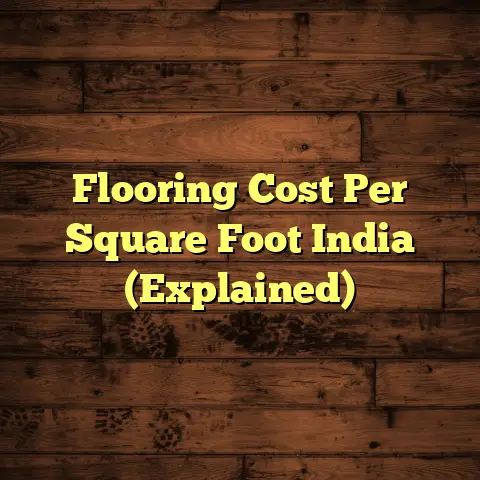How Much Cost To Remove Hardwood Floor? (Explained)
Removing hardwood flooring can be an intricate process, one that’s often fraught with challenges and surprises.
As a flooring contractor with years of hands-on experience, I’ve encountered my fair share of dilemmas and triumphs when it comes to this task.
This article will delve deep into the costs associated with removing hardwood floors, providing insights, experiences, and practical advice based on real-life projects.
While the initial thought of ripping up a floor might seem straightforward, it’s anything but.
I once thought I could quickly remove some old hardwood in my home, only to find hidden issues that complicated the entire process.
In this article, I’ll walk you through everything you need to know about the costs, challenges, and best practices for removing hardwood flooring.
Understanding the Costs of Removal
An Overview of Pricing
When considering removing hardwood floors, it’s essential to understand that costs can vary widely based on numerous factors.
On average, homeowners can expect to pay between $2 to $5 per square foot for removal.
However, this figure can fluctuate based on location, the type of hardwood, and the condition of the flooring.
For example, if you’re tackling a 1,000 square foot area, your total cost could range from $2,000 to $5,000.
But don’t be surprised if you find quotes that exceed these ranges—especially in high-demand areas like Los Angeles or Chicago, where labor costs can soar to about $7 per square foot.
A Closer Look at Price Components
- Labor Costs: This typically constitutes the bulk of your expenses.
Skilled labor is essential for ensuring that the removal process is done efficiently and safely.
In many cases, labor accounts for about 50-70% of the total cost. - Disposal Fees: Getting rid of old flooring isn’t just a matter of tossing it in the trash.
Many areas have strict regulations regarding waste disposal, especially for materials like hardwood.
You might incur fees depending on where you live. - Repair Costs: Once the flooring is removed, you may discover underlying issues with your subfloor.
These repairs can add unexpected costs to your project.
Factors Influencing Cost
Type of Hardwood
The kind of hardwood being removed plays a significant role in determining costs.
Solid hardwood floors tend to be easier to remove than engineered hardwood or exotic wood types.
For instance, I once had a project involving Brazilian cherry wood.
The installation was complex and required more time and expertise to ensure we didn’t damage any boards during removal.
Condition of the Floor
An old floor that’s been well-maintained is generally simpler to remove than one that’s damaged or infested with pests.
I’ve encountered floors with severe water damage that required extensive work just to assess the extent of the damage before proceeding.
Location
As mentioned earlier, location can significantly impact your total costs.
In urban settings where living expenses are higher, labor rates will naturally follow suit.
In my experience working in various cities, I’ve seen costs double in metropolitan areas compared to rural settings.
My Personal Experiences with Floor Removal
The Journey Begins
I remember one particular job that stands out in my mind.
A client wanted to replace their old hardwood floor in a charming bungalow built in the 1920s.
Initially, our discussions centered around aesthetics and choosing a new floor type.
Little did we know that the removal process would reveal more than just age-worn boards.
Upon starting the project, I quickly realized that the original flooring had been installed directly over a layer of tar paper and then glued down—a common practice in older homes.
This meant that our initial estimates were off by quite a bit.
The Challenges Unfold
As I began lifting the boards, it became evident that many were splintering.
We had to adjust our strategy on-the-fly.
Instead of simply prying them up, we needed to be meticulous about how we removed them to minimize damage and maximize salvageability.
Working late into the night, I often thought about how I could better prepare for such situations in future jobs.
One valuable lesson I learned was to always factor in a contingency budget for unforeseen complications.
Successes Along the Way
Despite the challenges we faced during this project, there were also remarkable moments of success.
By carefully removing sections of the hardwood floor and saving some pieces for reuse, we managed to reduce waste and keep costs down.
The clients were thrilled with our ability to salvage some of their original flooring for use in their new design plans.
Seeing their excitement reminded me why I love this job—helping people create spaces they love.
Tools and Techniques for Effective Removal
Having the right tools is crucial for a smooth removal process.
Here’s a list of essential equipment I always keep handy:
Essential Tools
- Pry Bar: A must-have for lifting boards without causing damage.
- Utility Knife: Great for cutting through adhesive or tar paper layers.
- Floor Scraper: Used for removing stubborn glue residues after flooring has been pulled up.
- Circular Saw: For cutting large sections when necessary—especially useful if you’re dealing with glued-down hardwood.
Techniques That Work
Over the years, I’ve developed techniques that streamline the process:
- Start at the Edge: Always begin removing boards from the edge of the room rather than in the middle.
This allows you to work your way inward systematically. - Use Heat: For glued-down floors, applying gentle heat using a heat gun can soften adhesives and make removal easier.
- Stay Organized: Keep track of which boards are being removed in case you want to salvage them later.
It helps keep things tidy and avoids confusion.
The Role of FloorTally in Cost Estimation
As mentioned earlier, accurate cost estimation is key when planning any flooring project.
That’s where FloorTally becomes invaluable for me as a contractor.
Simplifying Estimates
With FloorTally, I can input specific parameters tailored to each project.
For instance, when working on a recent job in Seattle, I was able to customize my estimate based on local material prices and labor rates.
This feature not only helps in creating accurate estimates but also allows me to present detailed breakdowns to clients.
They appreciate transparency, especially when they can see exactly where their money is going.
Visualizing Costs
Another standout feature is FloorTally’s visualization tools.
They enable me to show clients how their choices impact overall budgets visually.
For example, if they opt for a more expensive flooring material post-removal, they can immediately see how this decision affects their finances.
This approach fosters better discussions and ensures everyone is aligned before moving forward—ultimately leading to more satisfied clients.
Navigating Challenges
Hidden Issues Beneath the Surface
One thing I’ve learned is that every project comes with its surprises.
In one case, while removing hardwood flooring in an older home, we discovered substantial water damage beneath the boards.
This realization turned what was supposed to be a straightforward removal into a more complex restoration project.
We had to halt work temporarily while assessing the damage and formulating a plan for repairs.
It was frustrating at times; however, it reminded me of how crucial it is to conduct thorough inspections before starting.
The Importance of Inspecting Before You Remove
Before embarking on any removal project, I highly recommend conducting a detailed inspection.
Look for:
- Signs of water damage
- Pest infestation
- Condition of the subfloor
- Any existing mold or mildew
These checks can save significant time and money later on.
Unexpected Costs
While working on another project in New Orleans, we encountered hidden costs related to disposal fees.
The local regulations mandated that certain materials be disposed of at designated facilities only, which added an unexpected layer of complexity and expense to our budget.
To avoid such surprises in future jobs, I’ve made it standard practice to research local regulations concerning waste disposal before starting any project.
Practical Tips for Homeowners
If you’re contemplating removing your hardwood floors yourself or working with a contractor, here are some practical tips based on my experiences:
- Get Multiple Estimates: Always seek multiple quotes from different contractors before deciding who to hire.
Ensure you’re comparing apples to apples in terms of what’s included. - Include Contingency Funds: Set aside at least 10-15% of your total budget for unforeseen expenses—this could be critical if hidden issues arise during removal.
- Assess Your Skills: If you’re considering a DIY approach, assess your skill level honestly.
If you’re unsure about any aspect of the process, it’s worth hiring a professional. - Plan for Cleanup: Have a plan for disposing of the old flooring once it’s removed.
Make sure you know whether your contractor includes disposal fees or if you’ll need to handle this separately. - Document Everything: Keep thorough documentation throughout the process—this helps track progress and financials and serves as valuable information if issues arise later.
- Communicate with Your Contractor: If you’re working with someone else, ensure open lines of communication throughout the project.
Discuss any changes or issues as soon as they arise.
The Future of Flooring Removal
With advancements in technology and methodologies within the flooring industry, it’s exciting to think about what lies ahead in flooring removal processes.
New tools are being developed that promise efficiency gains and lower costs.
Innovative Tools on the Horizon
I’ve begun seeing companies introduce tools that minimize damage during removal or streamline the disposal process.
For example, some newer saws have dust extraction systems built-in—this not only keeps workspaces cleaner but also improves air quality during removal.
Eco-Friendly Practices
As sustainability becomes increasingly important to homeowners and contractors alike, finding eco-friendly disposal methods will be vital in future projects.
Many regions are beginning to implement recycling programs specifically for old flooring materials.
During one project last year, we managed to recycle 75% of removed hardwood through a local repurposing program—it was rewarding not only for us but also for our environmentally-conscious clients.
Conclusion
Removing hardwood flooring is a journey filled with potential obstacles and rewarding experiences alike.
By understanding costs upfront and being prepared for surprises along the way, homeowners can approach this task with confidence.
From my personal stories of challenges overcome to the lessons learned from successful projects, I’ve found that preparation and open communication are key components for success.
Tools like FloorTally have revolutionized how I estimate costs and communicate with clients—making every job smoother from start to finish.
Now it’s your turn!
Are you ready to take on your own hardwood removal project?
Whether you’re doing it yourself or hiring a contractor, knowledge is power—and I hope this guide empowers you as you move forward!





